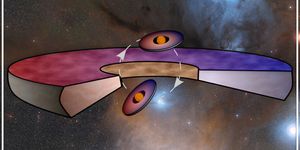New Discovery Reveals Where Jaw Evolution May Have Started
Biologists have long been stumped while thinking about where jaw evolution may have begun with life on Earth. One of the most likely candidates for jaw evolution has been traced back to placoderms, a type of pre-historic armored fish, which happen to be invertebrates.
There are all kinds of placoderms, since it's an umbrella term for a number of types of fish that existed at the time, but each fossil we find, ranging from 300-400 million years old, tells a different story. 3D-printed recreations of a recent placoderm fossil revealed hard bumps that resembled teeth, but their properties weren’t a direct match with the jaws and teeth we know of in modern fish today.
Researchers now believe they’ve found a type of placoderm that may have had actual jaws and teeth, illustrating a new hint in the evolution of jaws in animals on Earth for the very first time.

Image Credit: Dinghua Yang
Fossils based out of China of a different type of placoderm known as Qilinyu rostrata are revealing new information about this long-standing mystery. The findings are published in Science.
This 423 million-year-old fish exhibits a three-part jaw, including two bones up top and one on the bottom. It’s also the oldest placoderm fossil ever uncovered, so it brings up a number of concerns and questions related to other placeoderm discoveries and why not all of them have these features.
The fossil derived a lot of its featured from other placoderms like the Entelognathus, which use their “teeth” for grinding rather than chewing, but it also has features that appear to have started the gorundworks for the modern jaw structure we know of today.
In case that seems confusing, this is basically a type of hybrid between thet wo kinds of jaws that have been observed in different types of placoderms. This cross between the two may have set the building blocks for modern jaw evolution.
Both species have the same three bones, but the Qilinyu has a much more refined jaw structure more like modern animal species on Earth. It suggests they probably ate their food differently from other placoderms too.
Many of these placoderm fossils will found in the exact same region, suggesting they either co-existed or slowly evolved from one form to another over a long stretch of time. It’s difficult to tell, as dating back this far in history isn’t always 100% accurate.
There continues to be a lot of mystery surrounding the whole ordeal, but it definitely does seem to confirm that jaws and teeth evolved far before modern vertebrate fish came to be.
Now we know that one branch of placoderms evolved into modern jawed vertebrates," said study co-leader Zhu Min, a paleontologist at Chinese Academy of Sciences' Institute of Vertebrate Paleontology and Paleoanthropology. "In this sense, placoderms are not extinct."
As research continues in this field, the puzzle continues to slowly come together. Additional fossil samples are always being un-earthed that provide more clues into the evolution of jaws and teeth.
Source: Reuters








